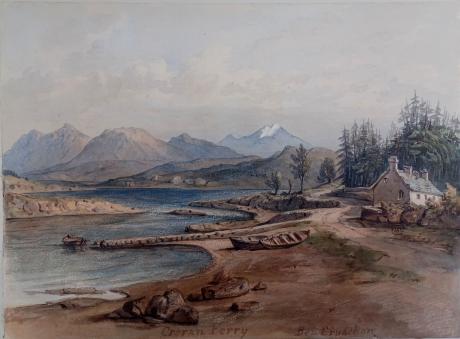inscribed " Creran Ferry Ben Cruachan" a page from an album inscribed in the frontispage "F W Staines 3 Uplands St Leonards on Sea"
Amelia Jackson, Nee Staines (1842 – 1925) and thence by descent
There were crossings along the shores of Loch Creran at different places through the years (centuries) : South Shian, Rhugarbh and Creagan
In many places these were associated with ale houses and hostels.
The South Shian ferry crossing is described, in none to glowing terms, by Dorothy Wordsworth in her Journal of her travels around Scotland in 1803, but it was better than the Connel Ferry crossing they had just undertaken.
We lost sight of the sea for some time, crossing a half-cultivated space, then reached Loch Creran, a large irregular sea loch, with low sloping banks, coppice woods, and uncultivated grounds, with a scattering of corn fields; as it appeared to us, very thinly inhabited: mountains at a distance. We found only women at home at the ferry-house. I was faint and cold, and went to sit by the fire, but, though very much needing refreshment, I had not heart to eat anything there - the house was so dirty, and there were so many wretchedly dirty women and children; yet perhaps I might have got over the dirt, though I believe there are few ladies who would not have been turned sick by it, if there had not been a most disgusting combination of laziness and coarseness in the countenances and manners of the women, though two of them were very handsome.
It was a small hut, and four women were living in it: one, the mother of the children and mistress of the house; the others I supposed to be lodgers, or perhaps servants; but there was no work amongst them. They had just taken from the fire a great pan full of potatoes, which they mixed up with milk, all helping themselves out of the same vessel, and the little children put in their dirty hands to dig out of the mess at their pleasure. I thought to myself, How light the labour of such a house as this! Little sweeping, no washing of floors, and as to scouring the table, I believe it was a thing never thought of.
After a long time the ferryman came home; but we had to wait yet another hour for the tide. In the meanwhile our horse took fright in consequence of his terror at the last ferry, ran away with the car, and dashed out umbrellas, greatcoats, etc.; but luckily he was stopped before any serious mischief was done. We had determined, whatever it cost, not to trust ourselves with him again in the boat; but sending him round the lake seemed almost out of the question, there being no road, and probably much difficulty in going round with a horse; so after some deliberation with the ferryman it was agreed that he should swim over. The usual place of ferrying was very broad, but he was led to the point of a peninsula at a little distance. It being an unusual affair, - indeed, the people of the house said that he was the first horse that had ever swum over, - we had several men on board, and the mistress of the house offered herself as an assistant: we supposed for the sake of a share in eighteen-pennyworth of whisky which her husband called for without ceremony, and of which she and the young lasses, who had helped to push the boat into the water, partook as freely as the men.
At first I feared for the horse: he was frightened, and strove to push himself under the boat; but I was soon tolerably easy, for he went on regularly and well, and after from six to ten minutes swimming landed in safety on the other side. Poor creature! he stretched out his nostrils and stared wildly while the man was trotting him about to warm him, and when he put him into the car he was afraid of the sound of the wheels. For some time our road was up a glen, the banks chiefly covered with coppice woods, an unpeopled, but, though without grandeur, not a dreary tract.
Francis William Staines was the last of a family of merchants from the City of London. Not only was he a successful businessman but he possessed a large independent fortune, such that he could devote his time to the cultivation of his talents in music and art. He was a brilliant amateur violinist, and also loved to spend much of his time painting. His daughter Amelia and her mother accompanied Mr Staines as he travelled throughout the country finding subjects for his painting. One area of the country that they visited frequently was Scotland and the Lake District, and Amelia grew particularly fond of the dramatic landscape of the Fells. Skelwith Bridge with the view of the hills around it 43 was one of her father’s favourite scenes. He painted landscapes and maritime paintings , exhibited 11 works at the RA including views on the Italian Coast, address in London, Hastings and St Leonards on Sea Susssex.

